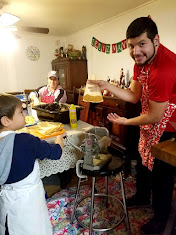In honor of Cinco de Mayo tomorrow, I thought I'd post a link to a short documentary I produced on Mexican American foodways, particularly, tortilla making, in Northwest Ohio. It features my friendand colleague, Gloria Pizano, a wonderful cook as well as scholar and activist.(https://www.youtube.com/watch?v=kBfK7amGoC8&t=218s)
One of the points of the video is that we all have foods that hold a special place in our memories of home--or places, people, past--and these oftentimes are overlooked because they seem so ordinary. They might also seem easy to make and not particularly special. Tortillas are a good example. They are ubiquitous and inexpensive, oftentimes taken for granted. As Gloria demonstrates in the video, though, there's a lot more to them than meets the eye or tongue.
Another aspect of the tortillas are the various associations with the flour used to make them. Corn flour (ground from corn treated with lye which releases the vitamins and softens the hull) is the traditional kind. Corn is native to Mexico and was domesticated there around 9,000 years ago! Wheat was brought in with the European colonists at the turn of the 1500s. It grew well in northern Mexico (which spread up into what later became Texas, New Mexico, Arizona, and California) and became established there. When migrants moved north from that region, they took their wheat flour tortilla traditions with them. Some Mexicans, though, consider only the corn tortillas to be authentic.
The holiday celebrates the victory over the French in 1862. It's not considered a big deal in Mexico, but it has become the public celebration of Mexican culture in the U.S.--I think, partly, because it fits so well into the calendar at a time when Spring really does seem to have arrived. In any case, it's a good excuse to try making tortillas (as shown in the video) and ordering take out from some of the many excellent Mexican American restaurants in this region. Most of these emphasize "Tex-Mex" dishes since much of the local population migrated up from Texas (and had lived in that area before it became the U.S.) starting in the 1930s to work in the sugar beet and tomato industries. For more information on this food culture, see the handouts on the website of the Center for Food and Culture (https://foodandculture.org/.../activity-guides-community.../).




No comments:
Post a Comment